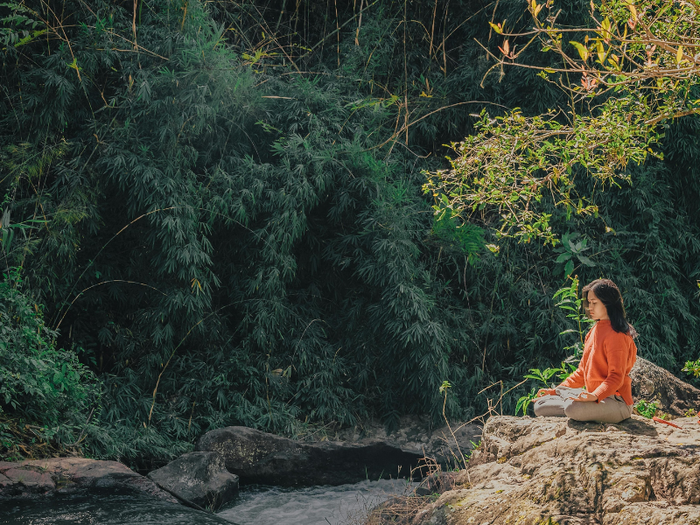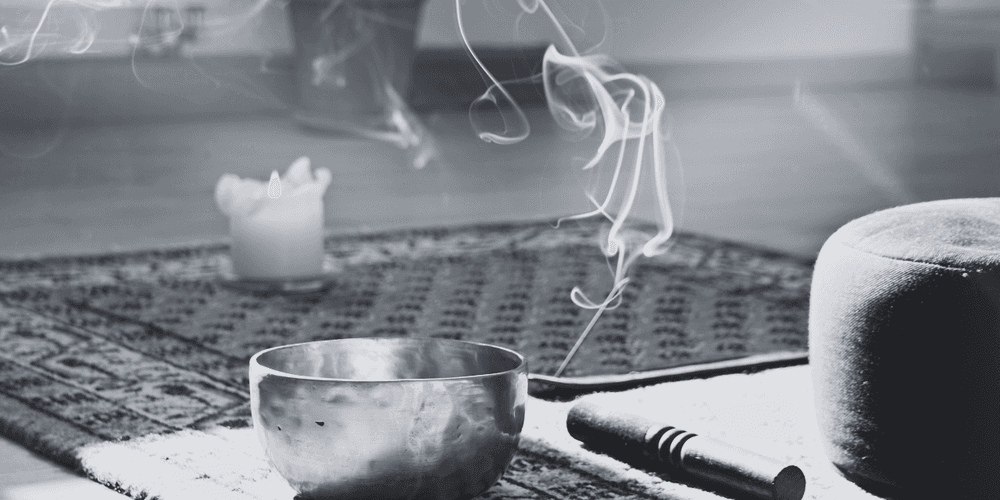We are excited to launch The Meditation Series. Join senior teachers Isabell Britsch and Graham Burns for a series of four 6 hour modules exploring all aspects of meditation practice and teaching. The modules can be taken independently or booked as a series – and those taking all four also have the option to gain Yogacampus Meditation Teacher certification.
Read Isabell and Graham's Q&A about practising and teaching meditation below:
What do you think is (potentially) missing from how meditation is often taught today—and how does The Meditation Series respond to that gap?
Many people, even in the yoga world, have a misconceived idea about what meditation is really all about, and also about its historical background. Much meditation taught today comes from a Buddhist background (including the modern ‘secular’ mindfulness practices) – this is absolutely fine, but meditation also plays a fundamental role in the non-Buddhist yoga traditions and some of the fascinating traditional yoga meditation techniques, for example involving visualisation or mantra, can often be hard to find. The important role of pranayama as a bridge between asana and meditation often also seems to be overlooked. In The Meditation Series, we aim to explore these areas: to de-bunk some of the misunderstandings about meditation, to encourage students to look at different meditation approaches and techniques, and to think about how meditation links with other modalities, such as asana and pranayama.
Many yoga teachers feel confident teaching asana but unsure when it comes to guiding meditation. Why do you think that is—and how does this series help shift that confidence?
In many places these days yoga is almost synonymous with asana, and many (though by no means all) yoga teachers seem to have limited personal experience of meditation. Most yoga teacher trainings place the vast majority of their focus on asana practice and teaching, and related areas such as anatomy and physiology. As a result, meditation often plays only a small role in yoga teacher trainings, if indeed it is included at all, so meditation, if it is included in a yoga class, can feel like an ‘add-on’, rather than an integral part of the class grounded in the teacher’s own personal practice. This is such a shame, as meditation is probably the one constant feature of all the historic yoga traditions. While The Meditation Series is not just for yoga teachers, one module will be devoted to teaching. We will focus not just on meditation teaching skills, but also on how effectively to integrate meditation into a general yoga class, with the aim of encouraging teachers really to find their own unique meditation teaching voice.
For a teacher who feels disconnected from their own practice or overwhelmed by the ‘noise’ of modern wellness, how might this course help them realign or re-ignite their purpose?
We hope that our non-dogmatic approach, the range of different techniques which we will share during the modules, and the information which we will share about the historical background of meditation and more recent neuro-scientific knowledge, will all encourage participants to question their own practice, to explore a variety of styles, and to spark their interest in trying some new ones. As part of the certification process for those who choose to take it, we will ask teachers to diarise and reflect on their own regular meditation practice. In our experience, this has proved an invaluable tool in encouraging practitioners to consider their practice, how it serves them, and how it may adapt going forward.
This course is both non-dogmatic and rooted in tradition—why is that balance important, especially for today’s teachers and students?
There are many different approaches to meditation – not just in Asian traditions like yoga or Buddhism, but across other spiritual traditions and also independent of any particular spiritual path. Just like asana, different types of meditation practice appeal to different people, and we think it is hugely important to acknowledge and respect that, encouraging people to find the styles and techniques which work for them. However, these approaches did not grow up in a vacuum: they are grounded in peoples’ enquiries over many centuries about the nature of the mind and the nature of reality, and an understanding of this is something else which sometimes seems to be missing in contemporary teaching. We think that it is really important that contemporary practitioners understand some of these enquiries, and why meditation played such a significant role in them, as well as understanding some of the more modern scientific investigations into the mind.
You’ve created a modular format with a certification option—what kind of teacher or practitioner were you thinking of when you designed that flexibility?
Anyone interested in meditation! We do not want to exclude people who are keen to explore meditation in more depth, but have no interest in teaching. Equally, we understand that there are people out there (teachers or otherwise) with a long established background in meditation practice who, for example, know a lot about the historical context, but would like to know more about the neuro-science – so those people are welcome to take just one or two of the modules if they don’t feel the need for certification.
Meditation is often taught from a single lens—whether yogic, Buddhist, or mindfulness-based. Why was it important to bring these traditions into dialogue with each other in this series?
Because they have always been in dialogue with each other! It can be so easy to view ancient traditions in isolation. Yet the reality is that there is plenty of historical evidence that those traditions debated with each other, and grew off each other. For example, there is plenty of academic research in recent years about the overlaps between the yoga of the Yoga Sutras of Patanjali (where meditation plays a massive role) and some of the Buddhist traditions. That is not to say that they always agreed – but they challenged each others’ ideas and that surely helped them to develop their own approaches to practice. Even the modern mindfulness movement, which is fundamentally a ‘secular’ practice, readily acknowledges its background within Buddhism. Perhaps we can challenge participants’ ideas a little – especially the idea that there is only ‘one correct way’ to meditate – and help them find the path which works best for them.
The final module explores trauma awareness and diversity. Why must teachers consider this when guiding meditation—and what happens when they don’t?
Meditation can help us to become more self-aware and support self-regulation – the ability to control our emotions, thoughts, and behaviour. It can guide us to stay present with our experience as it is right now without judging or avoiding it. And it can invite qualities like curiosity and compassion. This can be incredibly empowering, helpful, interesting and supportive, but for some people this process can also be unsettling, frustrating, triggering or bringing up feelings of shame or guilt. Inner awareness can be a help or hindrance. Asking someone to look at their inner world is a big deal! Meditation can become a real refuge for one person, while another person finds it overwhelming. Symptoms of stress could be aggravated and difficult emotions could be emphasised.
So generally speaking, it’s important to guide meditation in a way that is inclusive, invitational and adaptive rather than prescriptive, rigid and potentially alienating. Language plays a huge part here and so does our ability to modify practices to be inclusive to a variety of needs. An awareness of teaching in a trauma-sensitive way allows us to make practices accessible, safer and relevant, so that we can speak to the needs of people with a diverse range of lived experiences.
If someone is asking themselves “What next?” in their teaching journey, or feeling a sense of stagnation—what might they discover about themselves through this series? (deeper inquiry)
That is a really tough one, because everyone is different, and participants will come to the course, or to the individual modules, from all sorts of different backgrounds, and with all sorts of different expectations. We hope, though, that they will discover, or re-discover, the benefits of regular meditation practice on all sorts of levels and, if they are teachers, learn the skills to share those benefits with their students. While we would never encourage anyone to approach meditation as any sort of planning exercise, the mental space and clarity which regular meditation practice can bring can really encourage us to question what we are doing in the world and also give us the space to intuit some answers.
Related Courses

FREE TASTER: 'The Meditation Series' (new modular course!)
9th May 2025 • Online Live • Graham Burns Isabell Britsch
- Details and booking

Meditation Myths De-bunked (part of The Meditation Series)
3rd June 2025 • Online Live • Graham Burns Isabell Britsch
- Details and booking

Meditation Roots and Shoots (part of The Meditation Series)
15th July 2025 • Online Live • Graham Burns Isabell Britsch
- Details and booking

Guiding Meditation (part of The Meditation Series)
20th August 2025 • Online Live • Graham Burns Isabell Britsch
- Details and booking

Meditation is All in the Mind (or is it?) (part of The Meditation Series)
17th September 2025 • Online Live • Isabell Britsch
- Details and booking

Meditation Teacher Certification
1st October 2025 • Online Live • Graham Burns Isabell Britsch
- Details and booking
Related Articles

The Meditation Series
We are excited to launch The Meditation Series. Join senior teachers Isabell Britsch and Graham Burns for a series of four 6 hour modules exploring all aspects of meditation practice and teaching. The modules can be taken independently or booked as a series – and those taking all four also have the option to gain Yogacampus Meditation Teacher certification....

Specialist Course and Event Teachers Teacher Training Faculty

